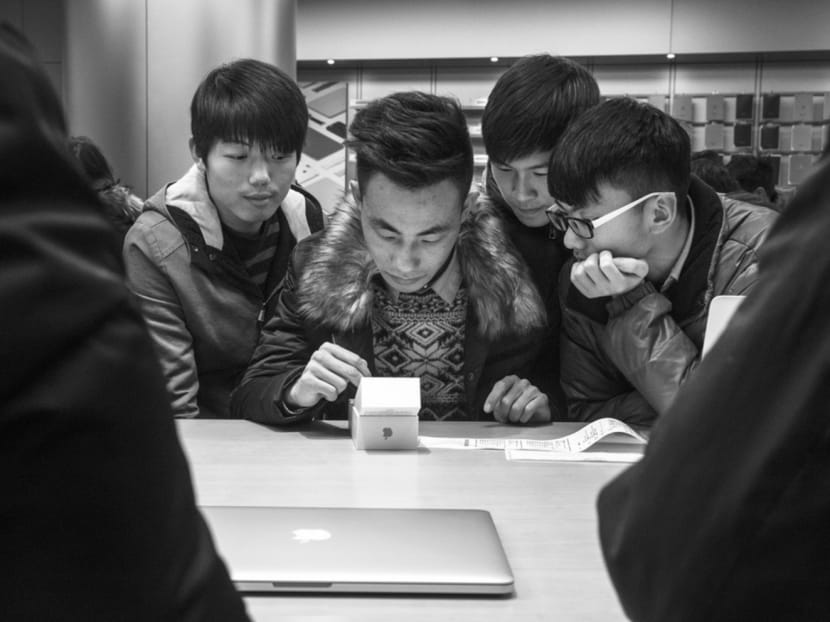The premium-isation of rural Chinese consumers
Apple’s iPhone SE might be one of the company’s least impressive products in years. Its tech specs have been available in other iPhone models and Android devices for months, and its form factor dates back to the early part of the decade. Its only distinguishing factor is an entry-level price — around US$500 (S$678) — that Apple executives are hoping will bolster its fortunes in China, where sales are badly sagging.

A man setting up his new iPhone 6s as friends look on at an Apple store in Beijing last year. Chinese manufacturers have begun selling phones with similar specs to recent iPhones — Apple is one of the most respected brands in China — but for several hundred dollars less. Photo: The New York Times
Apple’s iPhone SE might be one of the company’s least impressive products in years. Its tech specs have been available in other iPhone models and Android devices for months, and its form factor dates back to the early part of the decade. Its only distinguishing factor is an entry-level price — around US$500 (S$678) — that Apple executives are hoping will bolster its fortunes in China, where sales are badly sagging.
It is not a half-bad bet.
For the past five years, incomes have grown faster in China’s rural areas than in cities. Per capita rural incomes now top US$6,000 annually — a key threshold for consumer spending and enough, for some, to afford the new low-end iPhone. If Apple and other consumer goods companies want to continue growing in China, they clearly need to reach this demographic, which accounts for half of the population.
China as A Discerning, not developing, market
It will not be easy. Rural Chinese may have more money to spend, but not that much more: Their price points remain relatively low. At the same time, their expectations for quality are rising to converge with those of city folk. Global brands that could once depend on selling cheap to China need to learn how to sell better, without raising prices too much, or risk losing market share.
Disposable diapers are a case in point. In the 2000s, Procter & Gamble (P&G) popularised their use in China in part by pricing them as low as US$0.10 per diaper. P&G’s Pampers quickly became China’s most popular brand and stayed that way until the early 2010s, right around the time that rural incomes started to accelerate. Rather than buy more 10-cent diapers with that money, rural consumers started to seek out higher-quality products, with a strong preference for imported Japanese brands.
Pampers suffered a precipitous decline from which it has yet to recover. In February, P&G chief executive officer Dave Taylor explained the company’s mistake: “We looked at China too much like a developing market as opposed to the most discerning market in the world.”
The company is now pushing higher-end diapers that sell for as much as US$0.50 apiece — pricier than top-of-the-line Pampers in the United States market.
chinese LEERY OF LOW-END BRANDS due to scandals
This “premium-isation” of Chinese consumers is driven by a number of factors besides income. A series of high-profile food and drug scandals has made Chinese especially leery of low-end brands. Concerns about product quality, and a lack of accountability for manufacturers of shoddy goods, have fed the trend.
Food and personal products such as shampoo have been among the first categories to go upscale. According to McKinsey’s annual survey of 10,000 Chinese consumers, published in March, 46 per cent of respondents intend to spend more on food in the year ahead, with staples such as rice and milk among the most likely product categories to go premium.
Premium-isation is not only about fear. It also speaks to the growing sophistication of rural Chinese, most of whom now have access to the same online shopping platforms as their far wealthier counterparts in Shanghai.
According to McKinsey, 50 per cent of Chinese shoppers “now seek the best and most expensive product” when they shop, whether this is a pre-cooked frozen dinner or hair care product. The trend is obvious in any Asian airport duty-free shop. Flying from Singapore to Wuhan, China, last week, I was seated with a tour group from rural Hubei Province, most of whom were loaded down with high-end cosmetics, booze and electronics purchased in duty free.
Whatever their preferences, of course, rural Chinese only have so much to spend; smartphone ownership is growing fastest among those earning less than US$800 per month. Chinese manufacturers have recognised this instinctively; several are now selling phones with similar specs to recent iPhones — Apple is one of the most respected brands in China — but for several hundred dollars less.
It is working, too. Last quarter, Oppo and Vivo, two leading Chinese smartphone brands, saw their shipments increase 67 per cent and 56 per cent respectively, thanks to China’s “premium budget” customers.
The iPhone SE, released in late March, is targeted at those same consumers, out of a reasonable hope that they aspire to Apple’s quality pedigree and ecosystem. (In my experience, used iPhones continue to do a brisk business in smaller Chinese cities.) Although no sales figures are yet available, pre-orders exceeded a healthy 3.4 million in China, while one industry supply chain newsletter reports that Chinese handset makers are scaling back production due to the new competition.
Long term, all features being relatively equal, the SE has a chance to pace the competition. The key for Apple, as with any illustrious global brand, is to remain adaptable and to appreciate how sophisticated Chinese customers have become. For the right product, at the right price, China can still be the biggest market in the world. BLOOMBERG
ABOUT THE AUTHOR:
Adam Minter is an American writer based in Asia, where he covers politics, culture and business.






